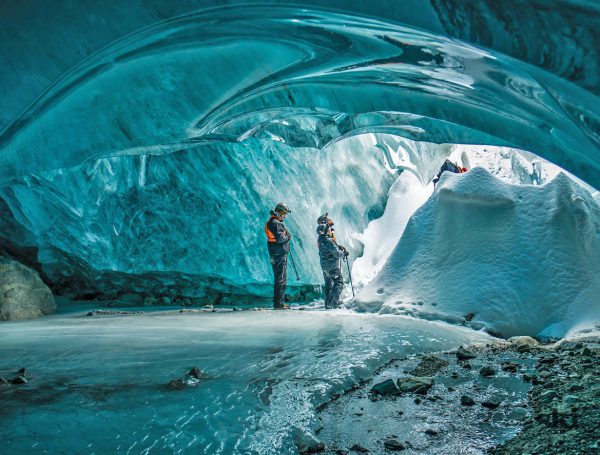Iceland and Thailand might boast their Blue Lagoons, but on the Pemberton Icefield west of Whistler, ice cave expert Doug Washer will show you more mesmerizing shades of blue than Benjamin Moore. Washer, CEO of Whistler-based Head-Line Mountain Holidays, is Canada’s foremost ice cave hunter.

How did you find these caves in the first place? Were they known to, say, backcountry skiers or snowmobilers?
I spend copious amounts of time on Google Earth looking for and researching micro-features to assess possible locations of ice caves. Then I follow up with a map and design flight paths for helicopter recon missions to prove my theories and hopefully find what I’m looking for. Based on the results from the reconnaissance, I then travel to those locations in the dead of winter with the deepest snowpack on snowmobile to assess their accessibility and structural integrity, and what key features they may possess.
Glaciers are snow-white on top but this crazy shade of blue underneath. Why is that?
Many factors contribute to the variety of blue hues we see in the various depths of the ice cave, but in the most simplistic terms, as you would expect more light means brighter hues and less means darker hues. Unlike the scattering spectrums of light we see in the sky or on water, light travelling into solid ice is compressed and blue and violet become the dominant spectrums. The ice, which over time and under great pressure, has compressed and squeezed out the air particles, leaving enlarged ice crystals that reflect the blue and violet hues better.
With global warming, aren’t glaciers inherently unsafe?
Global warming certainly contributes to the rate of change we see taking place today and is undeniably having effects on the ice cap and in the caves we explore. However, it’s important to remember that global warming started some 15,000 years ago. With respect to safe travel, we only explore ice caves with inherent design features and ice types that ensure maximum enjoyment and minimal risk. As part of our Ice Cap Research Initiative we call “White Is Green,” we photograph, monitor, assess and design strategies that mitigate any risk. Our ice cave team shares and interprets how these magnificent ice caves and myriad other features are formed, evolve and transition with time [as well as how to] safely travel within them.
A $1,395 tour includes helicopter transfers from Whistler plus snowmobile or snow buggy tours to the ice caves. More memorable après-ski: headlinemountainholidays.com.
by STEVEN THRENDYLE



